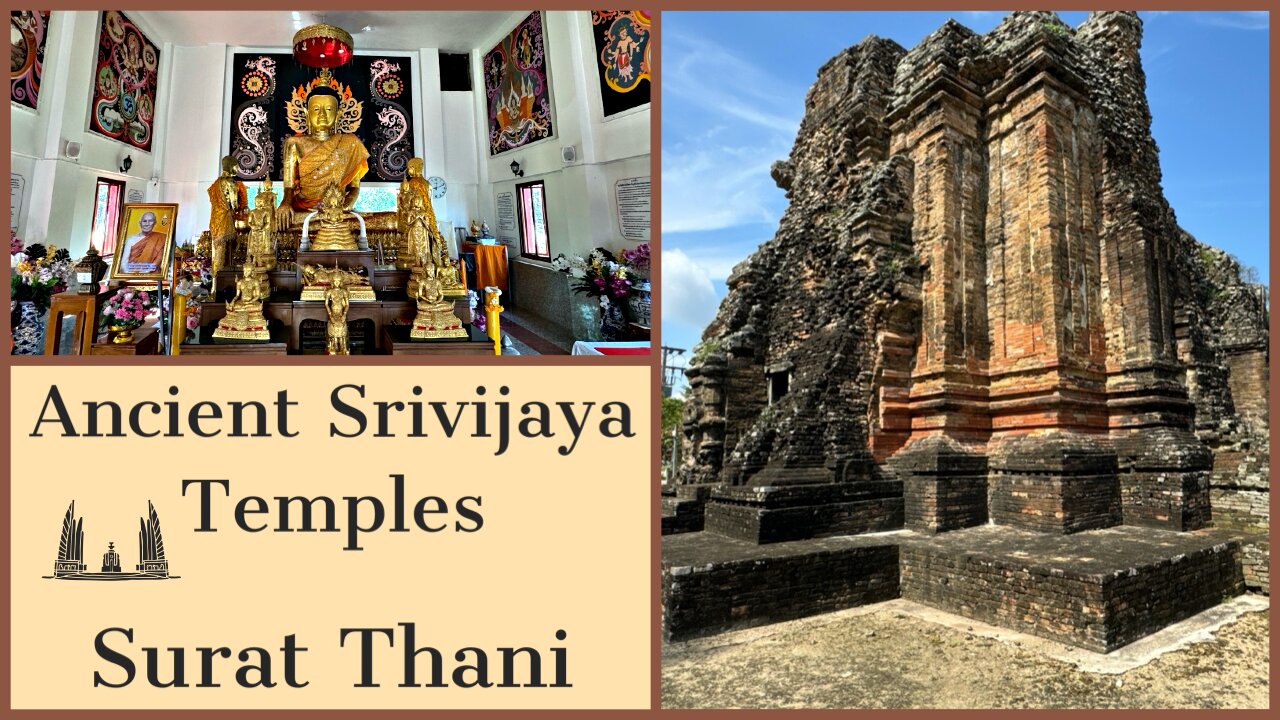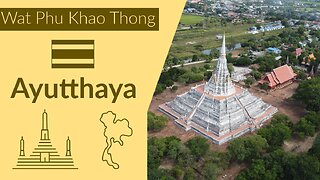Premium Only Content

Rare 1,200 Year Old Javanese Temples in Surat Thani - Wat Long, Kaeo & Rattanaram - Thailand 2024
Scholars generally agree that the Old Malay-speaking, seafaring Srivijaya kingdom was based in parts of Sumatra and Java, its influence spreading as far as the Philippines and Madagascar from around the seventh to the 13th centuries.
Southern Thailand had an important settlement north of Surat Thani in the Chaiya district. An important settlement on the coast that lost its importance due to the sediment building up along the coast and land locking this community.
These temples dates back to around 1,200 years ago and are a great part of the regions history.
Wat Kaeo
A massive stupa at Wat Kaeo was built of bricks without mortar on a square indented base in a crucifix design, marking a typical plan of Candi in Indonesia. The base features a plain square supporting the main chamber 18 meters on each side.
Remarkably the exterior walls of this monument feature the pilater decoration with a groove in the centre, resembling the Cham architectural style at the Mae Son temple in Vietnam. There are four porches inside the stupa facing four directions. The southem porch remains the most completed condition, decorated with plasters and the carving of Kudu-arch the Indian horseshoe-arched window) that presumably ilustrating the real buildings in miniature. Meanwhile, the eastern porch marks an entrance to the main chamber (Garbhagniha), measuring 4 metres on each side, where the seated Buddha image in the gesture of enlightenment is housed inside as the principal sculpture. This porch associates with the niches on the lateral sides of the porch, housing Buddha images. The architectural style of Wat Kaeo suggest its comparative dating to the same period with Wat Phra Mahathat Chaiya and Wat Long.
Plenty of artifacts were found here, namely stone Buddha images, sculptures in Hinduism, a fragment of a hand holding a lotus motif, architectural fragments, Chinese and Vietnamese ceramics as well as terracotta pots from Sukhothai and Ayuthaya.
These artefacts correspond to the belief mentioned on the inscription no.23 (Wat Sema Mueang Inscription) that Wat Kaeo might be one of the three monuments built in the reign of King Srivijaya for his merit dedicated to the Lord Buddha, the Bodhisatva Padmapani and the Bodhisattva Vajrapani.
There is a clue to the treasure-trove of Wat Kaeo; that is, "Wat Kaeo stupa was built by King Si Thammasoke, and its splendour could be outstandingly seen”.
Wat Long
The name of this monastery Long is presumably derived from "Luang', meaning royal as the grand monastery. Wat Long is an abandoned Buddhist monastery with a large ruin of a brick monument as its bricks were dismantled to build the monastery walls of Phra Mahathat Chaiya.
This monument was built on a square indented base of 21.65 meters on each side, resembling the large brick stupa of Wat Kaeo. Remarkably, the exteror wals of this monument feature the plaster decoraton, showing well polished bricks without mortar. The main entrance is main passageway to its most sacred room (Gardhagriha)
Presumably, this monument was built during the 9th and 10th centuries and it was rebuilt again during the 13th-17th centuries.
Historic periods of this temple are 9th-10th Centuries and the Ayuthaya period 14th-18th Centures.
There is also an estimated 1,000 year Buddha image inside the ordination hall of Wat Rattanaram that is built next to the ruins of Wat Kaeo.
Enjoy the video!
You can also see my videos on Rumble, Bitchute, Odysee and Subscribe Star. If you have any questions or comments and wish to contact me directly I can be reached by email at endlessjourneytravels@gmail.com
https://www.bitchute.com/channel/pYUe8EgYcUMc/
https://odysee.com/$/latest/@EndlessJourney
https://rumble.com/c/EndlessJourney
https://www.subscribestar.com/endless-journey
Follow me on Twitter @AEndlessJourney
#endlessjourney
#travel
#thailand
-
 17:22
17:22
Endless Journey
2 days agoWat Phu Khao Thong (The Monastery of the Golden Mount) - Built in 1387 - Ayutthaya Thailand 2025
11 -
 LIVE
LIVE
vivafrei
1 hour agoTrump Accuses Obama of TREASON! Macron SUES Candace Owens? Canada is Run By the INMATES! & MORE
12,224 watching -
 LIVE
LIVE
Dr Disrespect
4 hours ago🔴LIVE - DR DISRESPECT - 10 WINS CHALLENGE - BIG ANNOUNCEMENT AT 12PM PT
2,736 watching -

The Quartering
2 hours agoToday's Breaking News! Kohberger ROASTED In Court, Will Trump Prosecute Obama?
41.3K6 -
 LIVE
LIVE
Pop Culture Crisis
1 hour agoVanessa Kirby ALL OVER Pedro Pascal at FANTASTIC FOUR, Ozzy Reincarnated as AQUAMAN? | Ep. 883
402 watching -
 1:34:28
1:34:28
Russell Brand
3 hours agoTrump Accuses Obama of TREASON, Calls For CRIMINAL Charges - Epstein Deflection? - SF619
128K48 -
 LIVE
LIVE
Jeff Ahern
50 minutes agoNever Woke Wednesday with Jeff Ahern
108 watching -
 6:09
6:09
Rena Malik, M.D.
6 hours ago $0.01 earnedKidney Cancer Symptoms, Diagnosis and Treatment
881 -
 27:05
27:05
IsaacButterfield
10 hours ago $0.19 earnedThis Vegan Comedian Absolutely Lost Her Mind
9673 -
 1:43:29
1:43:29
Tucker Carlson
5 hours agoHow Wall Street & the FBI Colluded to Destroy Trevor Milton After His Tech Threatened Big Oil
54.7K43